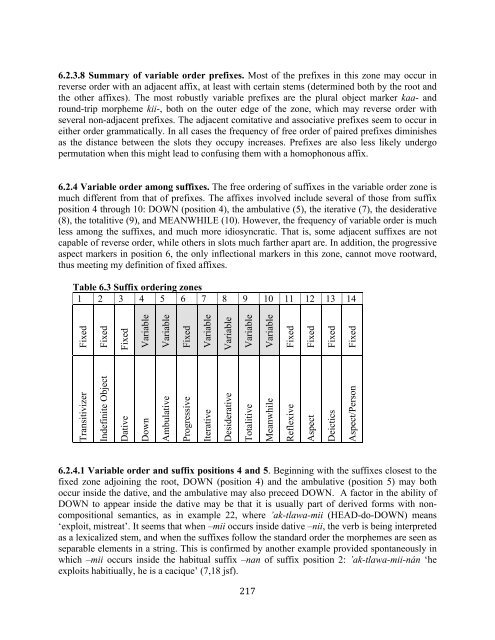The phonology and morphology of Filomeno Mata Totonac
The phonology and morphology of Filomeno Mata Totonac
The phonology and morphology of Filomeno Mata Totonac
Create successful ePaper yourself
Turn your PDF publications into a flip-book with our unique Google optimized e-Paper software.
6.2.3.8 Summary <strong>of</strong> variable order prefixes. Most <strong>of</strong> the prefixes in this zone may occur in<br />
reverse order with an adjacent affix, at least with certain stems (determined both by the root <strong>and</strong><br />
the other affixes). <strong>The</strong> most robustly variable prefixes are the plural object marker kaa- <strong>and</strong><br />
round-trip morpheme kii-, both on the outer edge <strong>of</strong> the zone, which may reverse order with<br />
several non-adjacent prefixes. <strong>The</strong> adjacent comitative <strong>and</strong> associative prefixes seem to occur in<br />
either order grammatically. In all cases the frequency <strong>of</strong> free order <strong>of</strong> paired prefixes diminishes<br />
as the distance between the slots they occupy increases. Prefixes are also less likely undergo<br />
permutation when this might lead to confusing them with a homophonous affix.<br />
6.2.4 Variable order among suffixes. <strong>The</strong> free ordering <strong>of</strong> suffixes in the variable order zone is<br />
much different from that <strong>of</strong> prefixes. <strong>The</strong> affixes involved include several <strong>of</strong> those from suffix<br />
position 4 through 10: DOWN (position 4), the ambulative (5), the iterative (7), the desiderative<br />
(8), the totalitive (9), <strong>and</strong> MEANWHILE (10). However, the frequency <strong>of</strong> variable order is much<br />
less among the suffixes, <strong>and</strong> much more idiosyncratic. That is, some adjacent suffixes are not<br />
capable <strong>of</strong> reverse order, while others in slots much farther apart are. In addition, the progressive<br />
aspect markers in position 6, the only inflectional markers in this zone, cannot move rootward,<br />
thus meeting my definition <strong>of</strong> fixed affixes.<br />
Table 6.3 Suffix ordering zones<br />
1 2 3 4 5 6 7 8 9 10 11 12 13 14<br />
Fixed<br />
Transitivizer<br />
Fixed<br />
Indefinite Object<br />
Fixed<br />
Dative<br />
Variable<br />
Down<br />
Variable<br />
Ambulative<br />
Fixed<br />
Progressive<br />
Variable<br />
Iterative<br />
Variable<br />
Desiderative<br />
Variable<br />
Totalitive<br />
6.2.4.1 Variable order <strong>and</strong> suffix positions 4 <strong>and</strong> 5. Beginning with the suffixes closest to the<br />
fixed zone adjoining the root, DOWN (position 4) <strong>and</strong> the ambulative (position 5) may both<br />
occur inside the dative, <strong>and</strong> the ambulative may also preceed DOWN. A factor in the ability <strong>of</strong><br />
DOWN to appear inside the dative may be that it is usually part <strong>of</strong> derived forms with noncompositional<br />
semantics, as in example 22, where ’ak-tlawa-mii (HEAD-do-DOWN) means<br />
‘exploit, mistreat’. It seems that when –mii occurs inside dative –nii, the verb is being interpreted<br />
as a lexicalized stem, <strong>and</strong> when the suffixes follow the st<strong>and</strong>ard order the morphemes are seen as<br />
separable elements in a string. This is confirmed by another example provided spontaneously in<br />
which –mii occurs inside the habitual suffix –nan <strong>of</strong> suffix position 2: ’ak-tlawa-mii-nán ‘he<br />
exploits habitiually, he is a cacique’ (7,18 jsf).<br />
! #"+!<br />
Variable<br />
Meanwhile<br />
Fixed<br />
Reflexive<br />
Fixed<br />
Aspect<br />
Fixed<br />
Deictics<br />
Fixed<br />
Aspect/Person

















